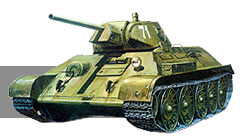|
Simultaneously with works over the further development BT-5's design (which was led by A. O. Firsov), in January 1933  KhPZ has been ordered to develop a new tank. It was supposed to improve some mistakes of the predecessors and equip it with a new M-17 engine — more reliable and powerful engine than the M-5, which was already used for BT-2 and BT-5 tanks; completely welded tank hull; increased fuel capacity and new turret with a 76mm gun. Thus, «the shock and long-range wheeled-tracked tank» was supposed to develop. KhPZ has been ordered to develop a new tank. It was supposed to improve some mistakes of the predecessors and equip it with a new M-17 engine — more reliable and powerful engine than the M-5, which was already used for BT-2 and BT-5 tanks; completely welded tank hull; increased fuel capacity and new turret with a 76mm gun. Thus, «the shock and long-range wheeled-tracked tank» was supposed to develop. The new tank development was conducted by special engineers group including Bondarenko, Doroshenko, Kurasov, Veselovsky, Tarshinov and Morozov. In the beginning of 1934 the design drawings were handed in manufacture and the new tank model has received the BT-7 designation. The first tank was completed by 1st May 1934, the second — by 7th November. The first samples of the BT-7 tank had a coaxial machine-gun and the original turret (an elliptical form with an oblique roof). In future it was supposed to arm it with a 76.2 mm KT or PS-3 Main Gun. During the summer-autumn 1934, the first tanks have passed an extended program of tests. As a result the coaxial machine-gun was recognized as unnecessary, it was removed and the whole turret was slightly redesigned. Therefore, at the beginning of 1935, the very first production BT-7 was very similar to its predecessor — BT-5. The dreams of the wheeled-tracked tank with a 76 mm gun weren't abandoned however, and the ABTU had ordered the  KhPZ to realize these ideas: to mount the turret from T-26-4 light tank on to BT-7's hull. KhPZ to realize these ideas: to mount the turret from T-26-4 light tank on to BT-7's hull. The 45 mm 20K gun and a DT machine-gun has been mounted in cylindrical turret. Some tanks (commanders tanks only) had the 71-TK radio instead of additional ammunition. The crew consisted of three men: a commander, a gunner, and a driver. Since 1937, the production of BT-7 with a conic turret begun. Tank armament was left unchanged, its ammunition was increased by additional 44 rounds though. For the effective night shooting a two special headlights have been placed on the gun's mantlet. Subsequently all earlier produced tanks were equipped with such headlights. The 4-speed gearbox was replaced with more modern 3-speed. The tank's chassis was improved as well. At the same time, the 154 pieces of BT-7A tank have been manufactured. The «A» letter means «artillery» and it's factory index was A-7M or A-8. That version had larger turret with the short barreled 76.2 mm KT gun installed in it. Gun was equipped with 50 rounds (tanks with a radio had 40 rounds). Some documents claims there were ideas to rearm it with the 76.2 mm long barreled L-10 gun on the BT-7A tanks. That claims seems to me incorrect because the L-10 was produced in a very limited number and that number was insufficient ever to rearm the T-28 medium tanks, so it was impossible to rearm BT's. In 1938 four newest BT-8 tanks with a diesel engine V-2 have been built in  KhPZ. After thecomparative tests (in 1940) of BT-7 and BT-8 production of a diesel tanks were begun. This powerful engine V-2 was designed for T-34 Medium Tank as well as for Voroshilovetz artillery tractor. To increase the production rate of the V-2 engines it's manufacture was allocated in an independent Factory #75. KhPZ. After thecomparative tests (in 1940) of BT-7 and BT-8 production of a diesel tanks were begun. This powerful engine V-2 was designed for T-34 Medium Tank as well as for Voroshilovetz artillery tractor. To increase the production rate of the V-2 engines it's manufacture was allocated in an independent Factory #75. The last attempt to modernise the BT-7 (increasing its armor protection) was undertaken just before the war. In 1940 the Mariupol factory has made a 50 sets of the additional homogeneous armor for BT-7M. From 1935 to 1940 the 5328 BT-7 tanks were built (exclude the BT-7A). They served in Red Army during the whole war. In 1945 these tanks were used last time in battles against Japan Army in Mongolia and China. Several experimental tanks were based on the BT-7: - BT-IS - a tank with improved chassis. Never served in the Red Army.
- BT-SV-2 — a tank (also called as «Cherepakha») with improved hull's and turret's form. Never served in the Red Army.
- KBT-7 — a commander tank. The «K» letter means «Komandirsky» — commander. On this tank the standard turret was replaced with a new non-revolving turret. Never served in the Red Army.
- OT-7 — a flamethrower tank. Never served in the Red Army.
- KhBT-7 — a chemical tank (armed with chemical weapons). The «H» letter means «Himicheskiy» — chemical. Never served in the Red Army.
- SBT - a bridgelayer tank. Never served in the Red Army.
- TTBT-7 — a radio-controlled tank. Never served in the Red Army.
- TUBT-7 — a radio-controlled tank. Never served in the Red Army.
Source: «Bronekollektsiya» #5 1996
|







 KhPZ
KhPZ

















